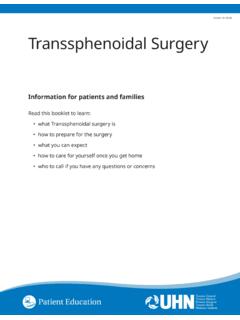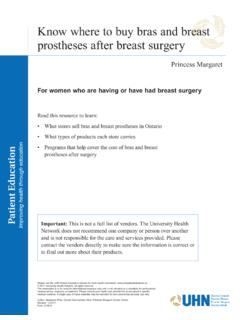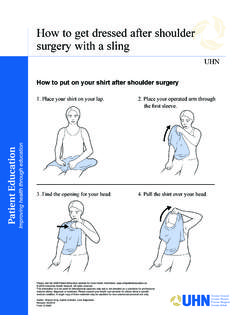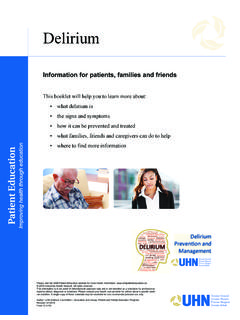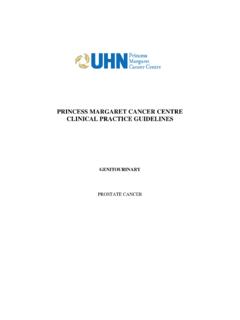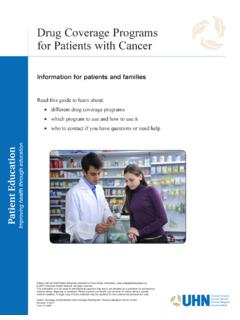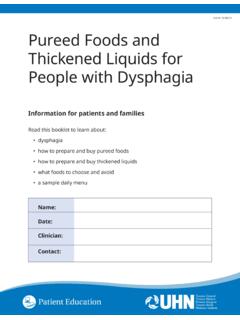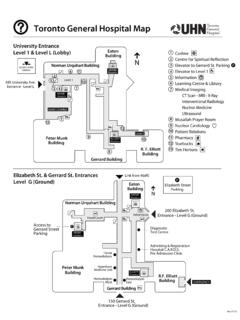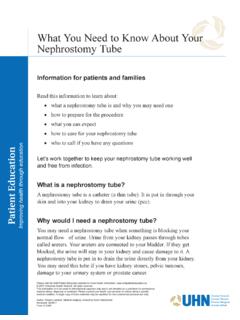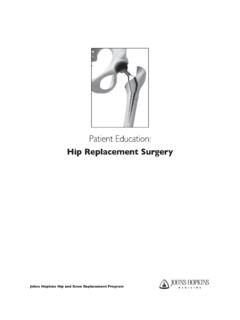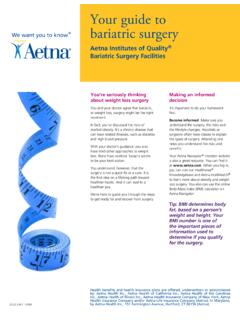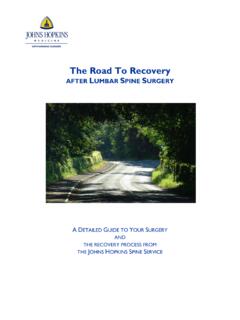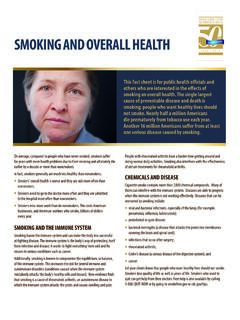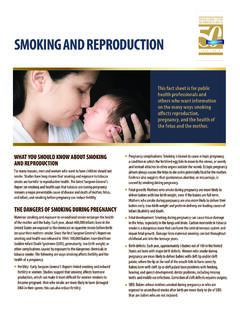Transcription of Leg Bypass Surgery or Repair to an Artery in Your Leg
1 Leg Bypass Surgery or Repair to an Artery in Your LegInformation for patients who are preparing for surgeryInside this booklet PageLearning about leg Bypass Surgery ..3 Preparing for Surgery ..7 What to expect in hospital ..11 Going home from the hospital ..18 Your recovery at home ..19 When should I get help? ..21 Who to call if you have questions ..21 Form: D-86952 Plans for your surgeryYour Surgery has been scheduled for:Date: Time: Come to the hospital at: Your Surgery is called: Leg Bypass Femoral Artery to Femoral Artery Bypass Graft Femoral Artery Repair Other You can expect to stay in the hospital for about: 2 to 4 days 4 to 7 days3 Learning about leg Bypass Surgery Why do I need Surgery ?
2 A large blood vessel ( Artery ) in your leg has become narrowed or blocked so less blood and oxygen is getting to the tissues in that leg and foot. This causes symptoms such as: leg muscle pain while walking (claudication) pain at night, especially in the feet (rest pain) feet and leg sores that won t heal dead tissue (gangrene) Surgery is needed to restore blood flow to your leg and foot. Without Surgery , your symptoms can become worse. Your leg may become numb or weak. You may develop infection or gangrene, and be at risk of losing your did the Artery get narrow or blocked?Over time, a fatty material called plaque has built up inside your arteries. This process is called atherosclerosis (hardening of the arteries). Blood flow slows down because plaque is in the did the plaque build up? There are risk factors that increase your chance of developing plaque over time.
3 Eating healthy, exercising regularly, and taking medication can help lower your Cigarettes, pipes, cigars and chewing tobacco all cause plaque build up in your arteries. The chemicals damage the inner lining of your arteries and increase your risk for atherosclerosis. If you smoke, quitting is the best thing you can do for your health. Diet High cholesterol contributes to plaque build up. Eating foods with less cholesterol and trans fats, and eating foods with more fibre can lower your risk. High blood pressure High blood pressure that is not controlled or treated is called hypertension. Hypertension puts stress on your heart, arteries and kidneys. Eating less salt, taking your medications, exercising, and relieving stress can keep your blood pressure in a healthy If you have diabetes, you are at a higher risk for developing plaque in your arteries.
4 High blood sugar levels can damage your heart, blood vessels, kidneys, eyes and nerves. It is important to follow the advice of your health care team about diet, treatment and types of Surgery can help?Your femoral Artery brings blood to your leg, foot and toes. Two types of Surgery on this Artery can help improve blood flow in the legs: Repair : A narrow or blocked Artery in the leg is cleaned out or repaired to improve blood flow. Your surgeon will make a cut in your leg near the blockage in your femoral Artery and carefully take the plaque off the walls. This will help your leg, foot and toes get blood. All cuts will be closed with stitches or staples. Bypass : A new tube is made to make blood go around ( Bypass ) the narrow or blocked section of the does leg Bypass Surgery help?Leg Bypass Surgery creates a new tube for blood to flow to your leg and foot, bypassing (avoiding) the section of the Artery that is narrow or blocked.
5 The new tube is called a graft. A graft can be a vein from your leg or arm (if suitable) or a flexible, artificial tube. Leg Bypass Surgery can be done in 2 ways: Leg Bypass : An incision (cut) is made from your groin area to your knee or further down your leg. One end of the graft is attached to the Artery at the top of your leg. The other end is attached to an Artery in your lower leg. The blood now flows through the graft, instead of through the section of the Artery that was narrow or blocked. Improving the blood flow to your foot can relieve pain and help to heal any open areas (ulcers) on your foot. This Surgery usually takes 3 to 4 hours. Femoro-femoral Bypass : Incisions (cuts) are made in your groin area. 6 One end of the graft is attached to the main Artery in your good leg. The other end is attached to the main Artery in your bad leg.
6 The blood now flows through the graft from your good leg to your bad leg, bypassing the blocked section of the Artery . The Artery in your good leg will supply blood to both does the surgeon decide which Surgery I need?To decide what type of Surgery is best for you, your surgeon will: Assess your symptoms Do a physical examination Review your medical history Review the results of your testsWhat tests will I have?Your tests may include: A leg ultrasound test called a Doppler. It measures blood flow in the legs compared to the arms. Imaging tests to map the blood flow, locate narrow or blocked arteries, and assess the vein that may be used as a example, a CT scan. In some tests, a dye is injected to make it easier to see your blood vessels in the images. Blood tests Tests to make sure your heart is strong enough to have surgeryWhen will I have Surgery ?
7 Your surgeon will explain the Surgery that is recommended for you and discuss the risks and benefits. If there is anything you do not understand or you need more information, please ask your you decide to have Surgery , you will sign a consent form. Then, the surgeon s office will schedule: 9 Your Surgery 9 Your visit to the Pre-Admission Clinic to help you prepare for surgery7 Preparing for Surgery You will have an appointment at the Pre-Admission Clinic within 2 weeks before your Surgery . This visit is very important to assess your health and help you prepare for your Surgery and recovery. Depending on your needs, this visit may take from 3 hours to the entire day. If possible, bring someone with you to help you remember information and ask you are given other instructions, you must come to your Pre-Admission Clinic visit or your Surgery will be should I bring to my Pre-Admission Clinic visit?
8 Please bring: Your Ontario Health Card (OHIP card) Any other medical insurance information you need for your hospital stay All medications you are taking, in their original bottles. This includes prescription medications, and the medication, supplements, herbs and natural products that you buy without a prescription. A copy of your power of attorney for personal care and/or advanced directivesOn the day of your Pre-Admission visit, take your medications and eat as usual, unless you were given other happens at my Pre-Admission Clinic visit?During this visit: You will fill out the paperwork for admission to the hospital. You will have tests, including blood tests, a chest x-ray, and an electrocardiogram (ECG) to check your heart. A nurse will ask you questions about your health and help you prepare for Surgery and recovery at home.
9 You will learn how to do deep breathing and coughing exercises that keep your lungs clear and prevent infection (such as pneumonia) after Surgery . The nurse will tell you when to stop eating and drinking before Surgery . The general rule is nothing to eat after midnight before Surgery . You can drink water or apple juice up to 5 hours before Surgery . Do not drink alcohol for 24 hours before your Surgery . For Surgery to be done safely, your stomach must be empty. The anesthetist will examine you and discuss what type of anesthetic and pain relief you will be given. A nurse or pharmacist will review your medications. They will tell you which medications to stop before Surgery , and which to take on the morning of your Surgery with a sip of can I prepare for Surgery at home? Make or buy extra meals and freeze them for after your Surgery .
10 Arrange for someone look after your family and pets while you are in the hospital. Arrange for someone to pick you up at the hospital on the day you expect to go home. Arrange for help at home during the first few weeks of your recovery. You may need help with groceries, cooking, laundry, cleaning and rides to medical appointments. If you smoke, it is important to stop. See the next page for the benefits of quitting smoking before smoking for safer Surgery , a faster recovery and better health smoking harms your body. Smokers often have more heart and breathing problems after you quit smoking before your Surgery , you may have fewer heart and breathing problems, and heal faster after Surgery . It is hard to quit smoking , but help is available! Talk to your doctor about programs and products that can help you smoking Cessation at UHN for helpful information and resources.
